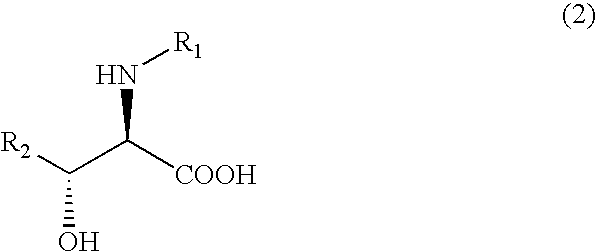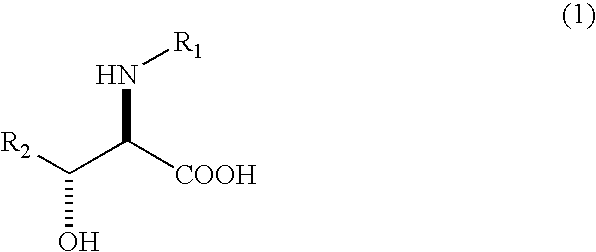Process for producing optically active erythro 3-cyclohexylserines
a technology of erythrocyclohexylserine and erythrocyclohexylserine, which is applied in the direction of biochemistry, organic chemistry, biochemical apparatus and processes, etc., can solve the problems of low yield, high cost of optical resolution agent, and small production ratio of erythro form compared with threo form, etc., to achieve high optical activity and high efficiency
- Summary
- Abstract
- Description
- Claims
- Application Information
AI Technical Summary
Benefits of technology
Problems solved by technology
Method used
Image
Examples
referential example 1
Production of N-acetyl-DL-erythro 3-phenylserines (Formula (B))
[0063] 11.0 g of DL-erythro 3-phenylserine ethyl esters were suspended in 30 ml of water, which was heated to 40° C. After dropping 42 ml of a 10% aqueous solution of sodium hydroxide, the suspension was further heated to 65° C. and stirred for 2 hours. After cooling this solution to 5° C., 4.6. g of acetic anhydride and a 1 N sodium hydroxide aqueous solution were added dropwise simultaneously while keeping the solution pH 10-13 and 10° C. or less. Then, the solution was stirred at room temperature overnight.
[0064] After adjusting the solution to pH 1 with hydrochloric acid, extraction was conducted with ethyl acetate. The obtained organic layer was washed with saturated saline, dried over magnesium sulfate, and vacuum-concentrated, to which a mixture of ethyl acetate and n-hexane (ethyl acetate:n-hexane=19:7) was added to precipitate crystals. The obtained crystals were filtrated and then vacuum-dried to give 5.79 g ...
example 1
Production of N-acetyl-D-erythro3-phenylserine (Formula (C)′)
[0065] To 2.23 g of N-acetyl-DL-erythro3-phenylserines (formula (B)) was added 100 ml of water to form a suspension, which was adjusted to pH 8 with aqueous ammonia. Inner temperature was set to 37° C.±5° C. by using a water bath. Thereto, 200 mg of L-aminoacylase (acylase “Amano”, produced by Amano Enzyme Inc.) was added. The mixture was stirred at 37° C.±5° C. for 68 hours and then additional 100 mg of L-aminoacylase was added thereto, and the mixture was adjusted to pH 8 with aqueous ammonia and allowed to react for 24 hours. To the reaction solution was added acetic acid to make it pH 5, then the reaction solution was heated to 60° C. and stirred for 1 hour. Subsequently, insoluble matter was filtrated and removed. After vacuum-concentrating the filtrate, 1 N aqueous hydrochloric acid was used to make it pH 3. To the solution was added sodium chloride and the solution was extracted with ethyl acetate. The obtained org...
example 2
(1) Production of N-acetyl-D-erythro 3-cyclohexylserine (Formula (D)′)
[0066] 0.9 g of N-acetyl-D-erythro 3-phenylserine (formula (C)′) obtained in Example 1 was dissolved in 20 ml of methanol. 5% rhodium-carbon was added thereto and the obtained mixture was stirred, under 0.9 Mpa hydrogen pressure, at 50° C. for 4 hours. The insoluble matter such as the catalyst was removed from the obtained reaction solution through filtration, and the filtrate was vacuum-concentrated to give 1.0 g of N-acetyl-D-erythro-cyclohexylserine (formula (D)′).
(2) Production of D-erythro 3-cyclohexylserine (Formula (E))
[0067] 1.0 g of N-acetyl-D-erythro 3-cyclohexylserine (formula (D)′) was suspended in a mixture of 10 ml of water and 3 ml of hydrochloric acid. The obtained suspension was heated and refluxed for 3 hours, thereafter, vacuum-concentrated, and to the obtained residue was added 40 ml of water, and the obtained solution was made to pH 7 using 28% aqueous ammonia to precipitate crystals. The o...
PUM
 Login to View More
Login to View More Abstract
Description
Claims
Application Information
 Login to View More
Login to View More - R&D
- Intellectual Property
- Life Sciences
- Materials
- Tech Scout
- Unparalleled Data Quality
- Higher Quality Content
- 60% Fewer Hallucinations
Browse by: Latest US Patents, China's latest patents, Technical Efficacy Thesaurus, Application Domain, Technology Topic, Popular Technical Reports.
© 2025 PatSnap. All rights reserved.Legal|Privacy policy|Modern Slavery Act Transparency Statement|Sitemap|About US| Contact US: help@patsnap.com



